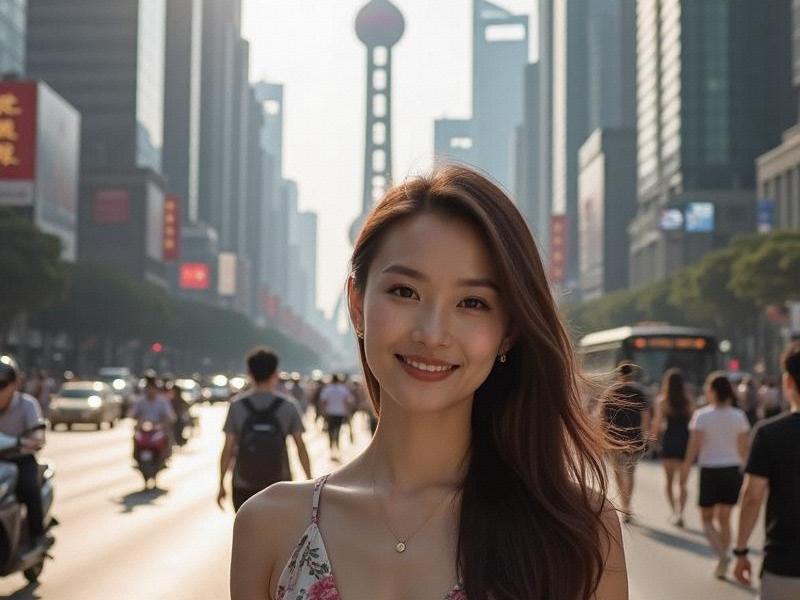Shanghai's Modern Beauties: How China's Fashion Capital Redefines Feminine Ideals
⏱ 2025-05-21 00:26 🔖 上海品茶工作室
📢0℃

In the neon-lit streets of Shanghai, a quiet revolution in feminine ideals unfolds daily. The Shanghai woman - often called "摩登女郎" (modern girl) in local parlance - represents a fascinating fusion of East and West, tradition and innovation, that makes her one of Asia's most distinctive urban female archetypes.
Historical Foundations:
Shanghai's beauty traditions trace back to the 1920s "Paris of the Orient" era, when qipao-clad socialites like Soong Mei-ling set sophisticated standards. The city's legacy as China's fashion birthplace continues today, with local women spending 23% more on beauty products than the national average (2024 Alibaba data). Traditional values like fair skin and delicate features remain prized, but reinterpreted through contemporary lenses.
The Shanghai Look Decoded:
Modern Shanghai beauty combines several signature elements:
1. "透明妆" (transparent makeup) - barely-there foundation emphasizing natural skin
2. Gradient lips - the Korean-inspired ombre effect adapted with softer colors
3. "伪素颜" (fake bareface) - meticulously crafted natural-looking makeup
4. Slim but curvaceous silhouettes - achieved through tailored clothing rather than extreme dieting
上海神女论坛 Fashion Districts as Battlegrounds:
Areas like West Nanjing Road and Xintiandi serve as open-air runways where style innovations emerge. Local designers like Helen Lee and Uma Wang have gained international followings by blending Chinese elements with modern cuts. The average Shanghai woman owns 37% more clothing items than her Beijing counterpart (Taobao 2024 Fashion Report), with rapid seasonal turnover driving the city's ¥87 billion apparel market.
Beauty Tech Revolution:
Shanghai leads China's cosmetech adoption, with:
- 62% of women using AI makeup apps daily (Meitu survey)
- 43% having tried virtual try-on for cosmetic surgery
- 28% subscribing to personalized skincare algorithms
Flagship stores like L'Oréal's "Tech Beauty Hub" on Huaihai Road offer DNA-based regimen consultations, reflecting Shanghai's high-tech approach to beauty.
The Working Woman's Armor:
上海龙凤sh419 For Shanghai's female professionals (who comprise 52% of management roles, versus 38% nationally), appearance serves as career capital. The "power bob" haircut - chin-length with razor-sharp edges - has become the signature look of finance district executives. Luxury brands like Shang Xia (Hermès' Chinese subsidiary) cater specifically to these discerning clients with qipao-inspired office wear starting at ¥8,000 per piece.
Cultural Contradictions:
Shanghai women navigate complex expectations:
- Embracing feminism while maintaining filial duties
- Pursuing career success but facing pressure to marry by 30
- Flaunting designer bags but downplaying wealth displays
This balancing act produces what sociologists call "pragmatic femininity" - using beauty as tool rather than trap.
Global Influences, Local Flavors:
While Shanghai women adopt global trends (French pharmacy skincare, Japanese cleansing routines), they adapt them distinctively. The current "茶艺妆" (tea ceremony makeup) trend combines Chinese porcelain-inspired complexion with Western contouring techniques. Similarly, traditional hairpins appear alongside Balmain blazers in street style photos.
上海龙凤419
Education and Empowerment:
Shanghai's female literacy rate (98.7%) and university attendance (62% female enrollment at Fudan University) crteeainformed beauty consumers. Women increasingly reject extreme measures (only 17% would consider double eyelid surgery vs. 41% nationally), favoring skincare investment (average ¥1,800/month) over quick fixes.
Future Directions:
Emerging trends include:
- "Slow beauty" emphasizing sustainability
- Male grooming acceptance (35% growth in men's beauty products)
- Reinterpretation of 1930s Shanghai glamour
As China's gateway city, Shanghai will continue setting beauty standards that ripple across Asia, proving tradition and progress need not conflict in the mirror of modernity.
Shanghai 2040: Where Futurism and Heritage Collide in China's Global MegacityShanghai 2040: How China's Global City Is Reinventing Urban LivingThe Phoenix of the East: How Shanghai is Reinventing Global Cultural InfluenceShanghai's Green Transformation: Pioneering Sustainable Urban Development in the 21st Century【摩登密码】从月份牌到元宇宙:上海女性审美百年流变录Shanghai's Vibrant Lifestyle, from Historical Pedigree to a Global Metropolis【特别调查】"共饮一江水:长三角生态绿色一体化发展示范区三年成效报告"【摩登密码】从石库门到元宇宙:上海女性的百年形象革命Shanghai’s Digital Elegance: Where Tradition Meets Tomorrow’s Frontier in BeautyShanghai's Nightlife Evolution: How Luxury Entertainment Clubs Are Redefining Urban Social Culture
海派烟火眉:上海美女的市井诗行与精神注脚《霓虹深处:南京东路百年商业街的进化论》《百乐门到元宇宙:上海娱乐会所进化论》霓虹与檀香:上海高端会所三十年文化流变"四段式模板
7. 历史参考:前两篇分别以"感官革命"和"时空折叠"为切入点,本次需创新视角
8. 时效元素:当前为2025年,可融入AI、元宇宙等现代科技元素
9. 价值导向:展现独立、智慧的当代上海女性形象,规避物化倾向
以下是符合要求的深度特稿:《梧桐树下的方程式:95后女科学家与旗袍实验室的双城记》《石库门密码:上海里弄建筑的时空折叠》《石库门里的时光标本》《梧桐树下的城市镜像》梧桐区镜像:上海女性的空间叙事与身份建构
空间修辞,身体政治,时尚语法,记忆拓扑,社群算法

